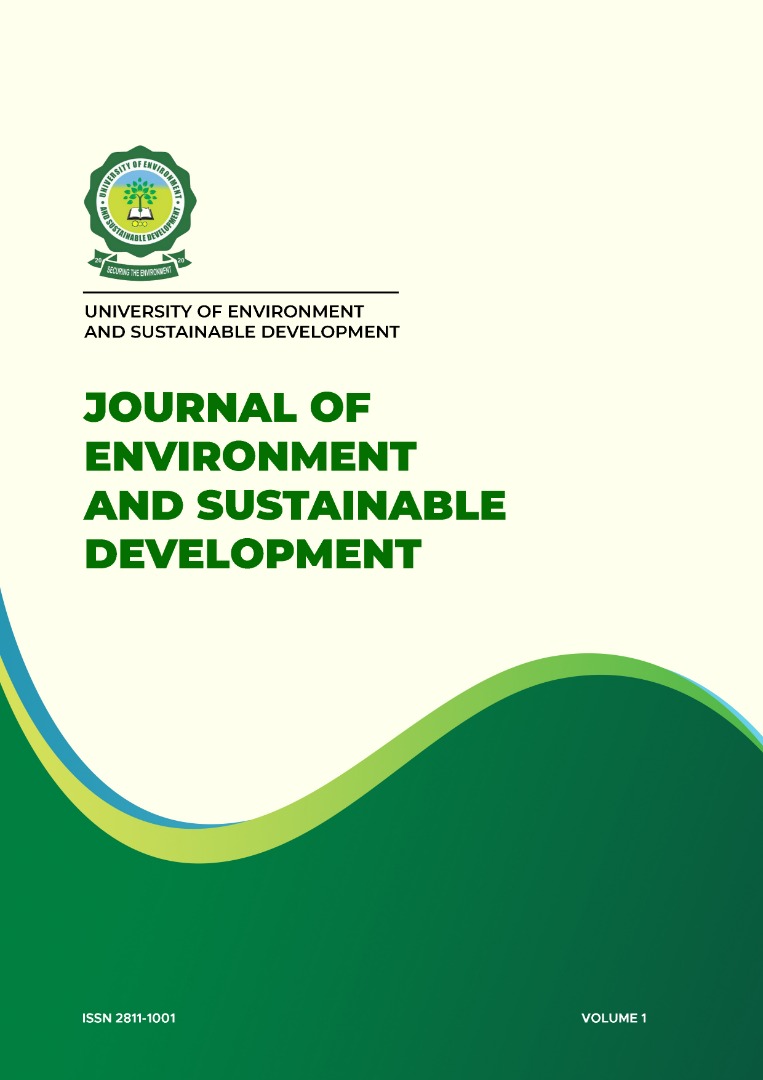Journal of Environment and Sustainable Development
Keywords:
Women, Women Educators, Business women, Information Communication Technology, Structural TransformationAbstract
Purpose –– The study examines women's participation in structural transformation and how ICTs are used in processes that support business enterprise using the current penetration rate of (ICTs) in the Ghanaian economy.
Methods –– A case study approach was adopted to investigate how women have used ICT to chart structural transformation in Ghana within the Manya and Yilo Krobo Municipalities.
Findings –– The study's findings revealed that some women educators and entrepreneurs in municipalities had adopted ICT to advance their businesses.
Conclusion/Recommendation –– The study identified that significant challenges confronted women in their quest to use ICT ranging from the high cost of equipment and data, high illiteracy rate, and unstable internet connections among others. It is recommended that the Assemblies should invest in public education initiatives as well as in specific ICT training and capacity building for women
References
Alibaba Group (2017). Annual Report. Form 20-F 2018 https://www.annualreports.com/Company/alibaba-group-holding-limited
Ametepey, S. O., Gyadu-Asiedu, W. & Ansah, S. K. (2020). State of Information and Communication Technology (ICT) Usage in the Training of Construction Students in Ghanaian Technical Universities, 2020; 5(3): 86-95.
Awotwi, J. E. & Owusu G. (2008). Lack of Equal Access to ICTs by Women: An e-Governance Issue. Retrieved from: http://ugspace.ug.edu.gh/bitstream/handle/123456789/29223/Lack%20of%20equal%20access%20to%20ICTs%20by%20women%20An%20e-governance%20issue.pdf?sequence=2&isAllowed=y
Basri, W. S. Alandejani, J. A. & Almadani, F. M. (2018). "ICT Adoption Impact on Students’ Academic Performance: Evidence from Saudi Universities", Education Research International, vol. 2018, Article ID 1240197, 9 pages, 2018. https://doi.org/10.1155/2018/1240197
Boyce, C. & Neale, P. (2006) “Conducting in-depth Interviews: A Guide for Designing and Conducting In-Depth Interviews”, Pathfinder International Tool Series. Retrieved from: https://research-methodology.net/research-methods/qualitative-research/interviews/#_ftn1
Brimacombe, T., & Skuse, A. (2013). Gender, ICTs, and indicators: Measuring inequality and change. Gender Technol Dev. 2013;17(2):131–57.
Chaparro-Peláez, J., Agudo-Peregrina, Á.F. & Pascual-Miguel, F.J. (2016), “Conjoint analysis of drivers and inhibitors of e-commerce adoption”, Journal of Business Research, Vol. 69 No. 4, pp. 1277–1282.
DiCaprio, A., & Suominen, K. (2015). Aid for Trade in Asia and the Pacific: Thinking Forward about Trade Costs and the Digital Economy. Report for the Asian Development Bank for the Global Aid for Trade Review, July. https://www.adb.org/sites/default/files/publication/167344/ aft-report- 2015. pdf.
Etsy (2017). Crafting the future of work: the big impact of microbusinesses. Retrieved from https://extfiles.etsy.com/advocacy/Etsy_US_2017_SellerCensus.pdf
Flavián, C. & Guinalíu, M. (2005), The influence of virtual communities on distribution strategies in the internet, International Journal of Retail & Distribution Management, Vol. 33 No. 6, pp. 405–425.
Fricker, R.D., & Schonlau, M. (2002). Advantages and disadvantages of Internet research surveys: evidence from the literature. Field Methods, 14: 347–67
Güney-Frahm, I. (2018). A new era for women? Some reflections on blind spots of ICT-based development projects for women’s entrepreneurship and empowerment, Gender, Technology and Development, 22:2, 130-144, DOI: 10.1080/09718524.2018.1506659
Hanna, N.K. (2010). Transforming Government and Building the Information Society: Challenges and Opportunities for the Developing World. New York: Springer
Hennig-Thurau, T., Malthouse, E.C., Friege, C., Gensler, S., Lobschat, L., Rangaswamy, A. & Skiera, B. (2010), The Impact of New Media on Customer Relationships, Journal of Service Research, Vol. 13 No. 3, pp. 311–330.
Hilbert M. (2011). Digital gender divide or technologically empowered women in developing countries? A typical case of lies, damned lies, and statistics. Women’s Stud Int Forum. 2011;34(6):479–89. https://doi.org/10.1016/j.wsif.2011.07.001.
Intel. (2013). Women and web. Retrieved from http://www.intel.com/content/dam/www/public/us/ en/documents/pdf/women-and-theweb.pdf
Jahanshahi, A.A., Zhang, S.X. & Brem, A. (2013), E-commerce for SMEs. Empirical insights from three countries, Journal of Small Business and Enterprise Development, Vol. 20 No. 4, pp. 849–865.
Kerras, H., Sánchez-Navarro, J. L., López-Becerra, E. I. & de-Miguel Góme, M, D. (2020). The Impact of the Gender Digital Divide on Sustainable Development: Comparative Analysis between the European Union and the Maghreb. Sustainability, 12, 3347 retrieved from: https://www.mdpi.com/2071-1050/12/8/3347/pdf
Kiran, Q. (2018). Role of ICTs in Women’s Economic Empowerment; The Case of Grameen Phones Bangladesh. Accessed on 11/07/2021 from https://wpmu.mah.se/nmict181group1/icts-women-economic-empowerment-grameen-phones-bangladesh/
Meera, K. J. (2013). Critical theory for women empowerment through ICT study, Quality Research Journal, Vol. 13(2) pp 163-177
Pearson, D., & Vossler, A. (2016). Methodological issues in focus group research: The example of investigating counsellors’ experiences of working with same-sex couples. Counselling Psychology Review, 31, 1.
Prasanna, R.P.I.R., Jayasundara, J.M.S.B.., Naradda Gamage, S.K., Ekanayake, E.M.S., Rajapakshe, P.S.K., & Abeyrathne, G.A.K.N.J. (2019). Sustainability of SMEs in the competition: A systemic review on technological challenges and SME performance. J. Open Innov. Technol. Mark. Complex., 5, 100.
Ramanathan, U., Subramanian, N. & Parrott, G. (2017), Role of social media in retail network operations and marketing to enhance customer satisfaction, International Journal of Operations & Production Management, Vol. 37 No. 1, pp. 105–123.
Shirazi, F. (2012). Information and Communication Technology and Women Empowerment in
Iran. Telematics and Informatics, 29, 1, 45-55.
Shana R. Ponelis & Marlene A. Holmner (2015). ICT in Africa: Building a Better Life for All, Information Technology for Development, 21:2, 163-177, DOI:
1080/02681102.2015.1010307
Smith, A.D. (2008). Modernizing retail grocery business via knowledge management‐based systems. Journal of Knowledge Management, Vol. 12 No. 3, pp. 114–126.
Sorescu, A., Frambach, R.T., Singh, J., Rangaswamy, A. and Bridges, C. (2011), Innovations in Retail Business Models, Journal of Retailing, Vol. 87, 3-16.
Stockdale, M.S. & Nadler, J.T. (2013). ‘Paradigmatic assumptions of disciplinary research on
gender disparities: The Case of Occupational sex Segregation’, Sex Roles 68, 3–4, 207– 215.
UN Women (2015). Progress of the world's women 2015‐2016: transforming economies,
realizing rights (Milan: UN Women), http://progress.unwomen.org/en/2015/pdf/UNW_ progressreport.pdf (accessed on 10 June 2021).
Varadarajan, R., Srinivasan, R., Vadakkepatt, G.G., Yadav, M.S., Pavlou, P.A., Krishnamurthy, S. & Krause, T. (2010), Interactive Technologies and Retailing Strategy. A Review, Conceptual Framework and Future Research Directions, Journal of Interactive Marketing, Vol. 24 No. 2, pp. 96–110.
Web Foundation (2014). ICTs for Empowerment of Women and Girls: A research and policy advocacy initiative on empowering women on and through the web in 10 countries. http://webfoundation.org/docs/2015/05/WROProjectFramework.pdf
World Bank Group (2015). In Ethiopia, female entrepreneurs get a chance to pursue their dreams. Retrieved from: http://www.worldbank.org/en/news/feature/2015/11/16/in-ethiopia-female-entrepreneurs-get-achance- to-pursue-their-dreams


